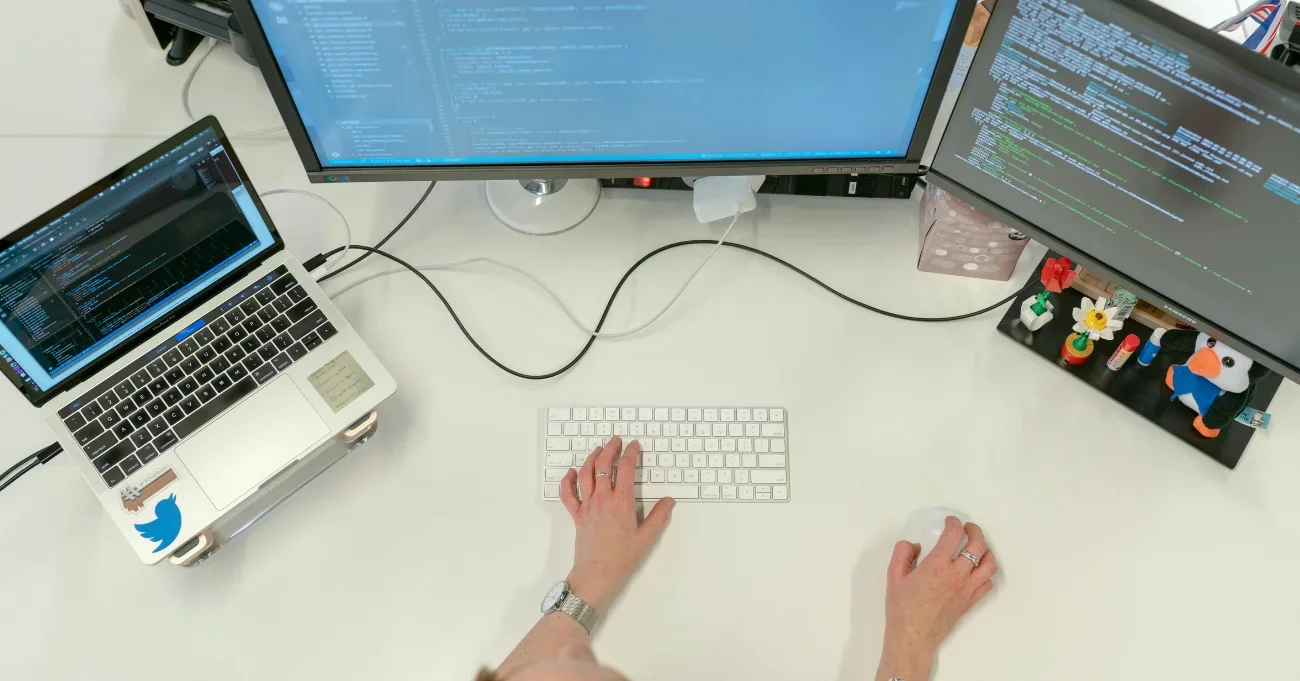The demand for full stack MERN developers continues to grow. Understanding the MERN stack is crucial for startups, businesses, and decision-makers. This technology stack simplifies web development, making it easier to build web applications efficiently. With JavaScript as a single programming language, it streamlines the entire development process from frontend to backend.
Aloa, an expert in software outsourcing, helps businesses and startups navigate this landscape. We provide insights into the MERN stack and its components, aiding web application development. Our approach ensures companies understand the development process and how to use this technology stack effectively. We support you in implementing best practices for web application development.
Anchored by our foundational principles and industry experience, we’ve put together this guide to explore the concept of MERN development. We'll explore its web development use cases, process, and steps to becoming a full stack MERN developer. At the end of this blog, you will understand how to make informed decisions and utilize MERN full-stack development in your projects.
Let's jump in!
What Is Full Stack MERN?
A full stack MERN is a combination of technologies used for building dynamic web applications. These technologies form a single-language, full-stack JavaScript environment that covers everything from the database layer to the user interface. It is a preferred choice for many web developers and large enterprises.
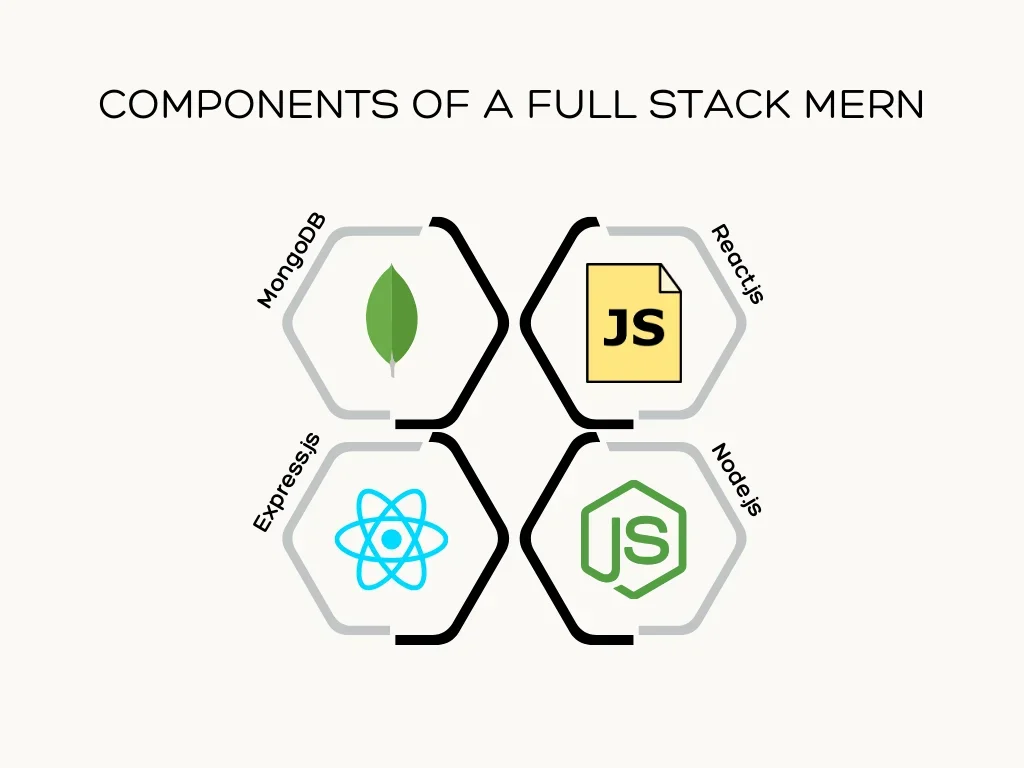
Here are the components of a full stack MERN:
- MongoDB: A NoSQL database that stores data in JSON-like documents. MongoDB provides a flexible query language, making it a preferred choice for many full-stack developers. It forms the database layer of the full MERN stack, handling data management and storage.
- Express.js: A lightweight framework for Node.js used to build server-side applications. Express.js manages HTTP requests and defines the application layer of the MERN stack. It simplifies routing and middleware configuration, making it easier to handle project requirements.
- React.js: A JavaScript library for building user interfaces. React.js allows full-stack developers to create dynamic web applications and react apps with a seamless user interface. It forms the front-end component of the MERN stack, enhancing user experience and reducing the learning curve.
- Node.js: A runtime environment that executes JavaScript code outside a web browser. Node.js enables server-side scripting, making it essential for MERN development. It forms the core of the MERN stack, allowing developers to run the entire application in a single JavaScript environment.
The full MERN stack offers a comprehensive solution for building dynamic web and mobile applications. Its components work together seamlessly, creating a powerful combination of technologies. Whether developing a new project folder or managing a large enterprise, the full stack MERN stack proves to be a versatile and efficient choice for modern software development.
MERN Full Stack Use Cases
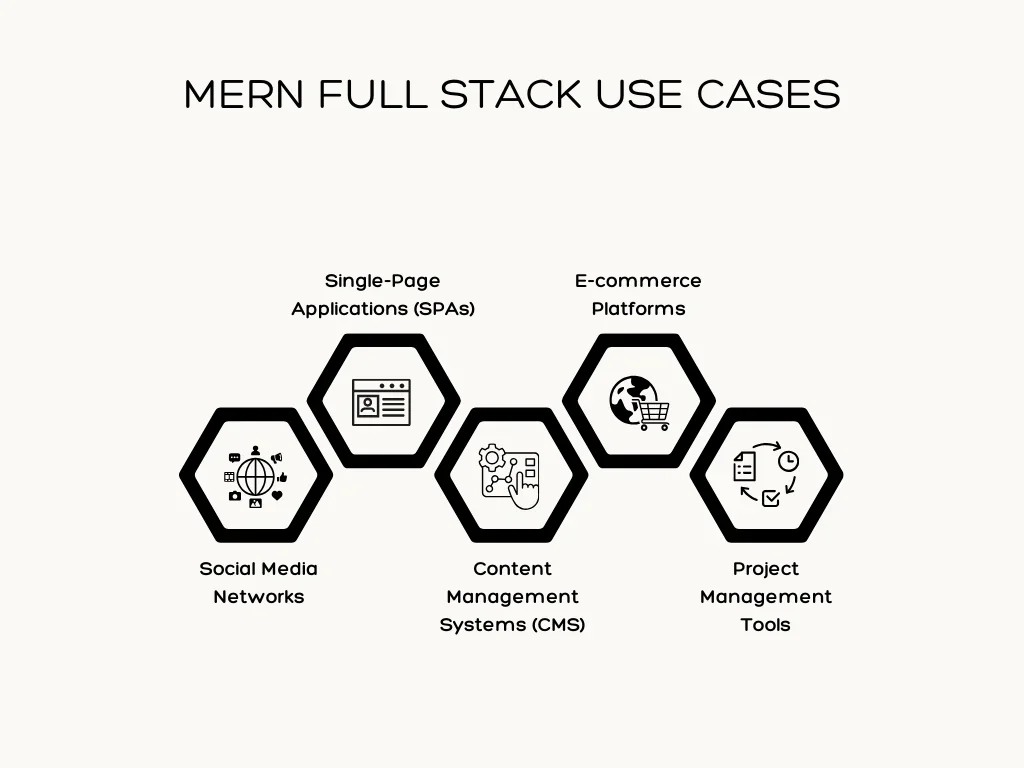
The full stack MERN offers a powerful solution for developing modern web applications. Many startups, businesses, and decision-makers prefer the MERN stack for its efficiency and versatility. Let’s explore five common use cases for the full stack MERN.
1. Single-Page Applications (SPAs)
Single-page applications (SPAs) benefit significantly from the full stack MERN. React, part of the MERN stack, enables dynamic updates without reloading the page, ensuring a smooth user experience. Companies use SPAs for speed and responsiveness. Examples include Gmail and Trello.
2. E-commerce Platforms
E-commerce platforms require robust and scalable solutions. The full stack MERN perfectly meets these needs. MongoDB provides flexible data storage. Express.js and Node.js handle backend operations efficiently. React generates engaging and interactive user interfaces. Companies like Shopify utilize similar stacks to power their online stores.
3. Social Media Networks
Building social media networks demands real-time data handling and a seamless user experience. The full stack MERN excels in these areas. React enables fast and dynamic content updates. Node.js handles numerous simultaneous connections. Platforms like Facebook and LinkedIn showcase the potential of stacks like MERN.
4. Content Management Systems (CMS)
Content Management Systems (CMS) allow users to create, manage, and modify website content without technical expertise. The full stack MERN offers a robust framework for developing CMS solutions. MongoDB stores diverse content types. Express.js and Node.js manage backend processes. React provides an intuitive front-end interface. WordPress and Joomla demonstrate the effectiveness of similar systems.
5. Project Management Tools
Project management tools require real-time collaboration features and efficient data handling. The full stack MERN supports these requirements well. MongoDB stores project data. Node.js and Express.js manage backend functionalities. React delivers a user-friendly interface for tasks, timelines, and collaboration. Tools like Asana and Monday.com exemplify the capabilities of stacks similar to MERN.
How Does the MERN Full Stack Work?
The MERN full stack is a robust framework for building dynamic and scalable web applications. Here's how this full-stack architecture operates seamlessly to bring your projects to life:

1. Client-Side Development
In the MERN stack, client-side development revolves around React.js. React enables developers to create interactive user interfaces easily. Using React components, developers fetch data from the server using HTTP requests, usually facilitated by RESTful APIs. This approach ensures a smooth user experience and efficient management of the application's state.
2. Server-Side Development
On the server side, Node.js and Express.js collaborate to handle incoming requests, process data, and interact with the database. Express.js provides a robust framework for constructing RESTful APIs, while Node.js ensures swift and efficient I/O operations. This combination empowers developers to build robust server-side logic that powers MERN applications.
3. Data Storage
MongoDB is the cornerstone of data storage in the MERN stack, housing data in a flexible, JSON-like format. Leveraging MongoDB's rich query language and schema-less design, developers can seamlessly store and retrieve data. This flexibility proves invaluable as applications evolve and data structures morph over time.
4. Middleware Integration
Express.js middleware assumes a pivotal role in the MERN stack, intercepting incoming requests and executing various operations such as authentication, logging, and error handling. These middleware functions enhance the security and performance of MERN applications, ensuring smooth operation even under demanding conditions.
5. Deployment and Scaling
MERN applications can be deployed across various hosting platforms, from mainstream cloud services like AWS and Azure to specialized platforms. Containerization technologies such as Docker facilitate effortless deployment and scaling, guaranteeing optimal performance and reliability. With MERN's versatility, developers can confidently launch and scale their applications to meet growing demands.
Advantages of Using MERN Full Stack
The MERN technology stack offers developers an efficient way to build and manage complex web applications. It enables smooth, dynamic, real-time updates, making it ideal for developing social media platforms, interactive forums, and other user-focused applications. Here are five key functions of the MERN stack and how they enhance web application development:
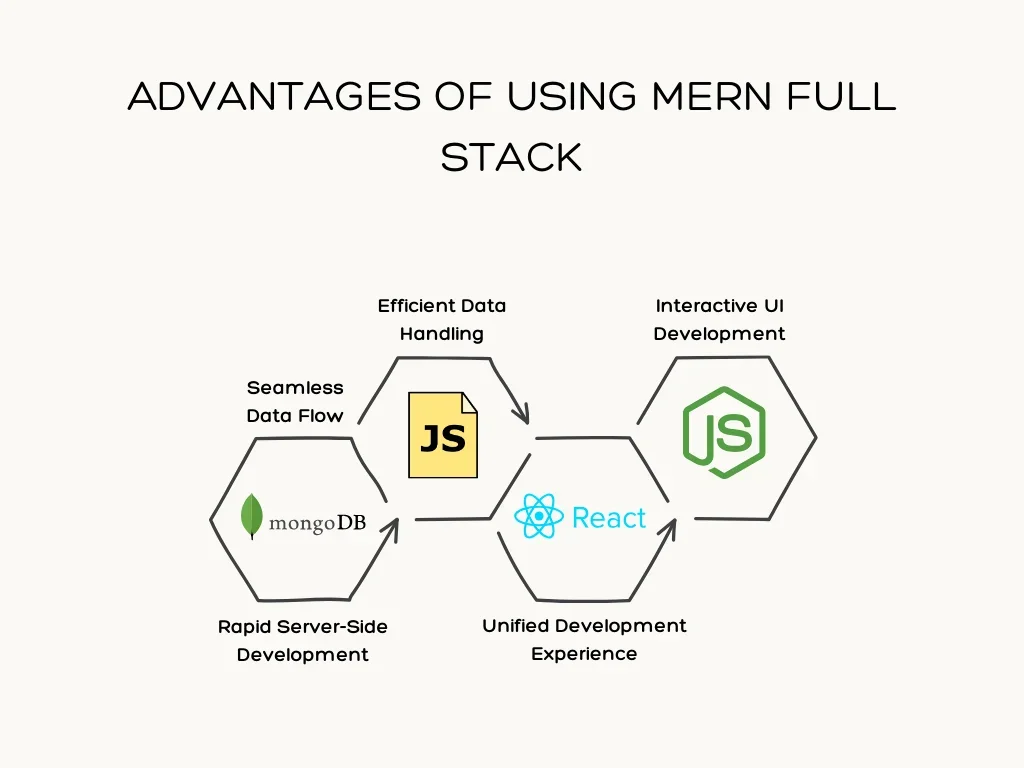
1. Seamless Data Flow
The MERN stack utilizes MongoDB, a NoSQL database, to manage data. MongoDB stores data in flexible, JSON-like documents, ensuring seamless data flow between client and server. This flexibility allows developers to build and scale applications more efficiently.
2. Rapid Server-Side Development
Node.js provides a runtime environment that lets developers use JavaScript on the server side. This integration speeds up the development process because developers use the same language throughout the application. Furthermore, Node.js supports numerous packages and extensions that enhance its functionality.
3. Efficient Data Handling
Express.js, running on Node.js, handles the server-side operations. It simplifies the routing and middleware setup, making data management easier and more efficient. Express.js streamlines frontend and database interactions, ensuring that data handling remains robust and scalable.
4. Interactive UI Development
React.js is used to develop the user interface. This JavaScript library enables the creation of dynamic and responsive user interfaces. With React.js, developers can build complex features like single-page applications (SPAs) that provide seamless user experiences. Its component-based architecture allows for reusable UI components, which accelerates the development process.
5. Unified Development Experience
The MERN stack offers a unified JavaScript development experience, reducing the complexity typically associated with learning different programming languages for different layers of development. The MERN stack ensures teams collaborate more effectively and maintain code consistency across the application's full stack.
How to Become a Full Stack MERN Developer
Becoming a full stack MERN developer opens many doors in the tech industry. The MERN stack combines various components to build dynamic web applications. Here are the five steps to mastering the MERN full-stack development process:
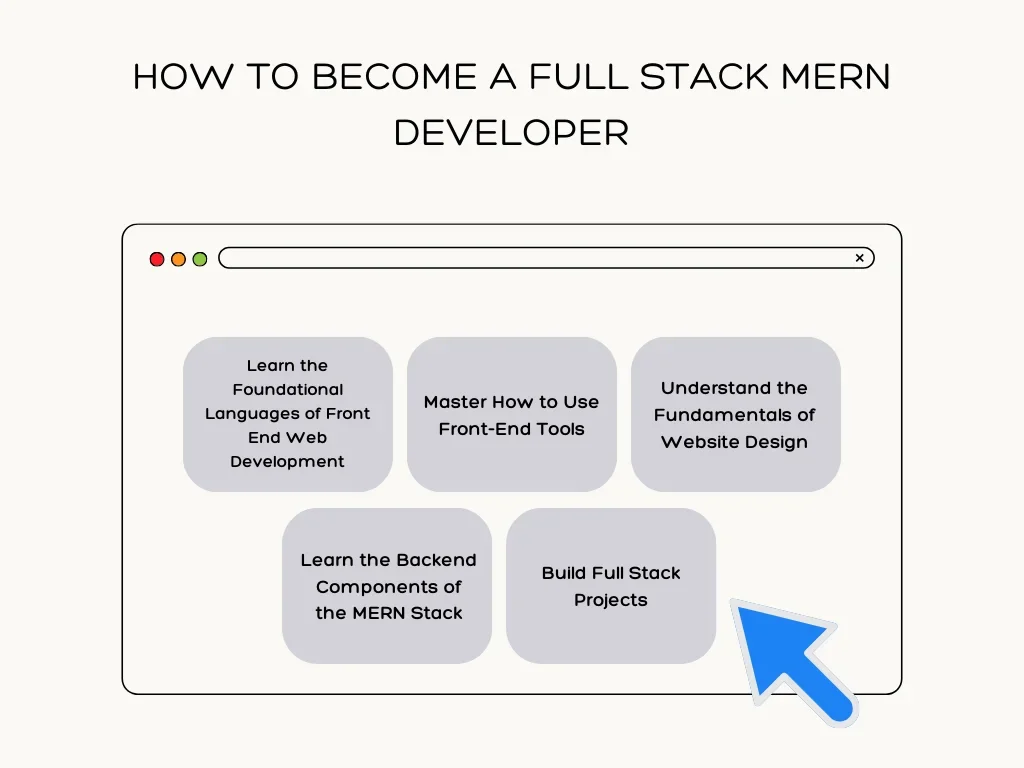
Step 1: Learn the Foundational Languages of Front End Web Development
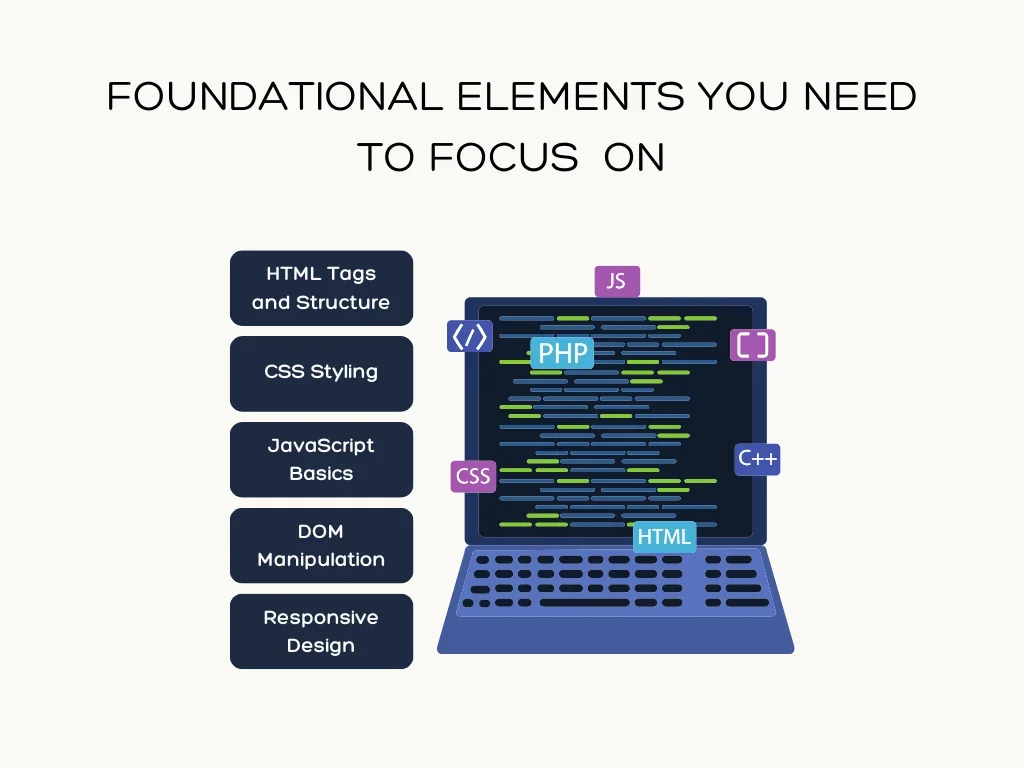
Start your journey to becoming a full stack MERN developer with HTML, CSS, and JavaScript. These three languages form the core of web development. HTML structures your web content, CSS styles it, and JavaScript adds interactivity. Here are the foundational elements you need to focus on:
- HTML Tags and Structure: Learn how to use tags like <div>, <p>, <h1>, and others to create the structure of your web pages.
- CSS Styling: Understand how to apply styles with classes, IDs, and elements to make your web pages visually appealing.
- JavaScript Basics: Master variables, loops, and functions to add dynamic behavior to your web pages.
- DOM Manipulation: Learn how to use JavaScript to interact with the Document Object Model (DOM) to change the content and structure of your web pages in real-time.
- Responsive Design: Learning about media queries and responsive design principles ensures your web pages look good on all devices.
Practice coding regularly to enhance your skills. Build simple web pages to see how these technologies work together. Focus on understanding each concept deeply. This solid foundation will make learning the MERN stack easier.
Step 2: Master How to Use Front-End Tools
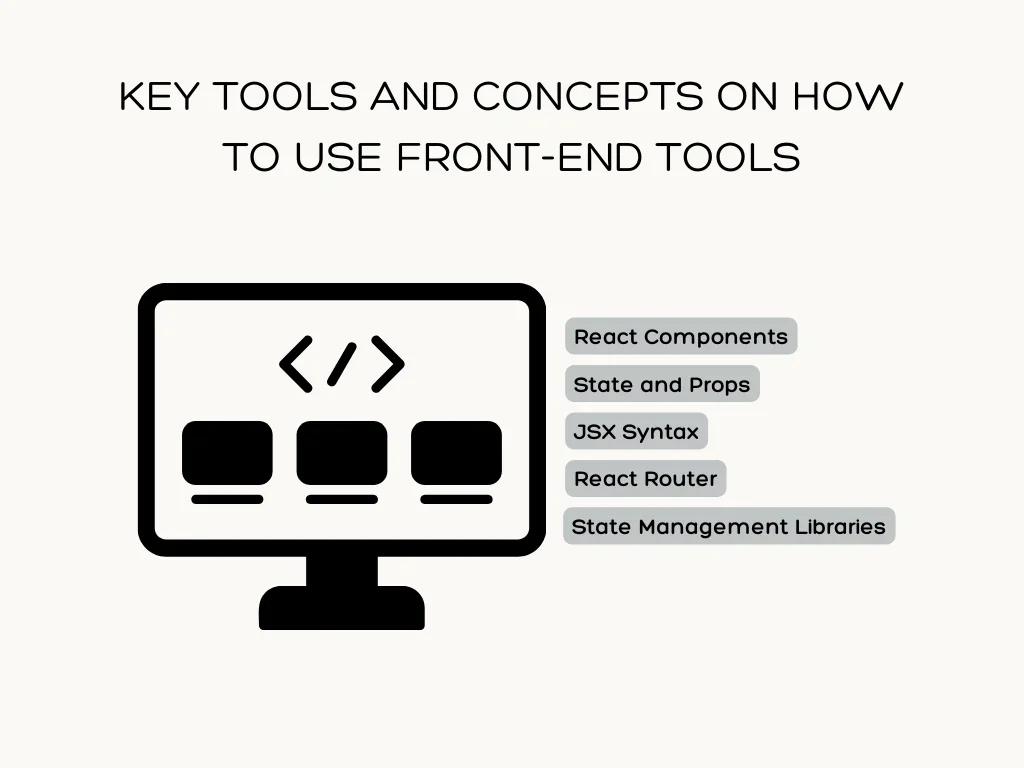
Next, focus on mastering front-end tools, especially React. React is crucial in the MERN stack, helping you build efficient user interfaces. Here are the key tools and concepts to learn:
- React Components: Understand how to create and manage components, the building blocks of React applications.
- State and Props: Learn how to manage data within components using state and props.
- JSX Syntax: Get comfortable with JSX, a syntax extension for JavaScript that makes writing React components more intuitive.
- React Router: React Router handles application routing, enabling seamless page navigation.
- State Management Libraries: Explore libraries like Redux to manage complex states across your application.
Understanding these tools will streamline your development process. Practice creating small projects to see how React simplifies building user interfaces. Explore how Babel and Webpack can enhance your workflow. Gaining proficiency in these tools will set you up for success in full stack MERN development.
Step 3: Understand the Fundamentals of Website Design
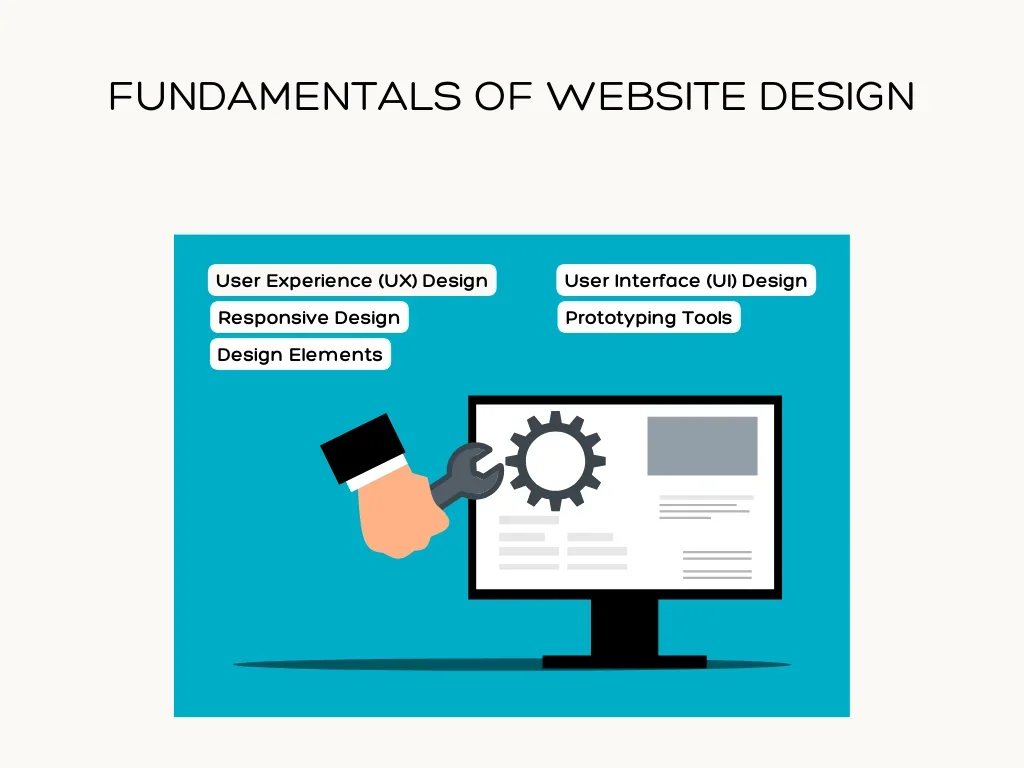
Good design is essential for a full stack MERN developer. Understanding UX/UI principles will help you create user-friendly and visually appealing web applications. Focus on these fundamental design concepts:
- User Experience (UX) Design: Learn how to create designs that provide users with a smooth and intuitive experience.
- User Interface (UI) Design: Understand how to design functional and aesthetically pleasing interfaces.
- Responsive Design: Ensure your websites work well on all devices, from desktops to smartphones.
- Prototyping Tools: Use tools like Figma or Sketch to create prototypes of your designs before coding.
- Design Elements: Study color theory, typography, and layout to enhance the visual appeal of your applications.
Creating well-designed web applications enhances user engagement. Practice designing and building responsive web pages. Use design principles to guide your development process. Solid design skills will differentiate you as a full stack MERN developer.
Step 4: Learn the Backend Components of the MERN Stack
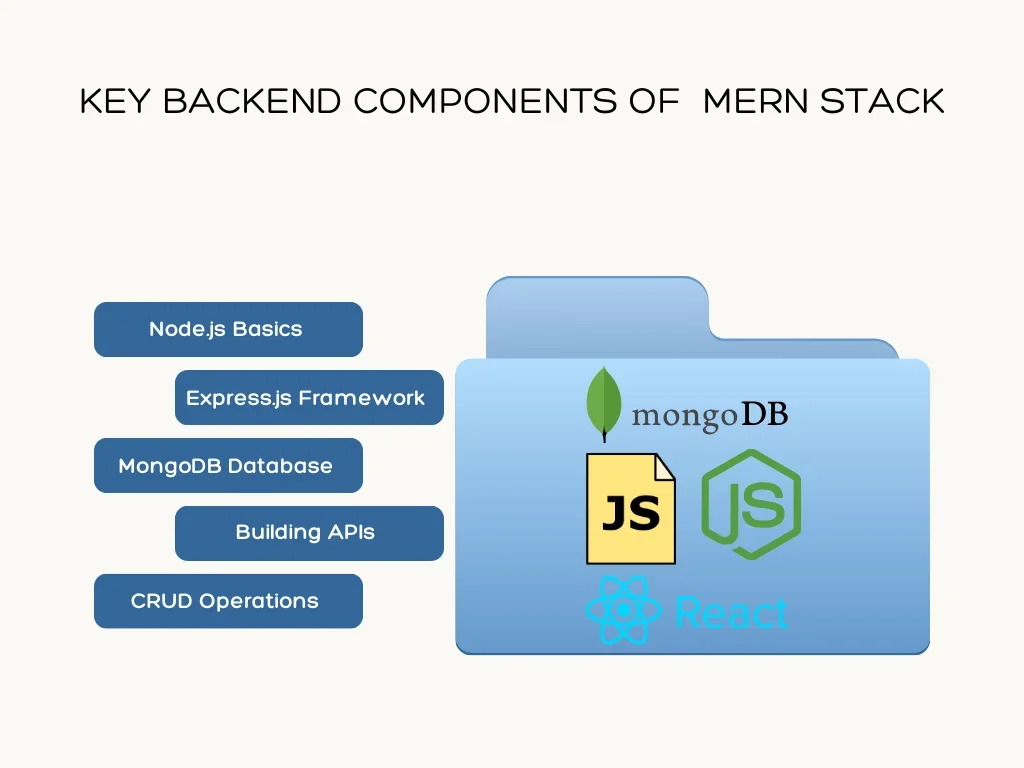
Dive into the backend components of the MERN stack. These technologies power the server side of your applications. Here are the key backend elements to focus on:
- Node.js Basics: Learn how Node.js allows you to run JavaScript on the server, enabling scalable network applications.
- Express.js Framework: Understand how Express.js simplifies routing and server-side logic.
- MongoDB Database: Get comfortable with MongoDB, a NoSQL database that stores data in a flexible, JSON-like format.
- Building APIs: Practice creating APIs to handle data requests and responses between the client and server.
- CRUD Operations: Learn to create, read, update, and delete operations with MongoDB.
Practice building APIs and connecting them to front-end applications. Understand how to handle data effectively. These skills will help you manage the backend of your full stack MERN applications efficiently.
Step 5: Build Full Stack Projects
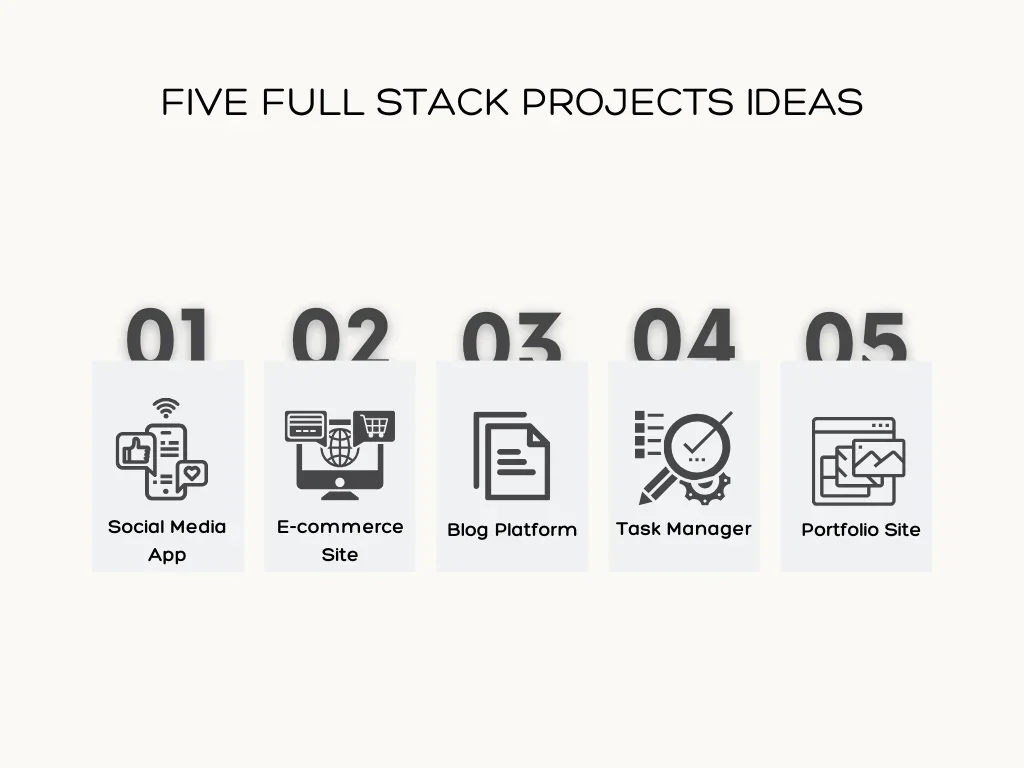
Put your knowledge into practice by building full-stack projects. Creating real-world applications solidifies your understanding of the MERN stack. Here are five project ideas to get you started:
- Social Media App: Build a platform where users can post updates and interact with each other.
- E-commerce Site: Create a shopping website with product listings, a shopping cart, and a checkout process.
- Blog Platform: Develop a site where users can create, edit, and publish blog posts.
- Task Manager: Build an application that helps users track and manage their tasks.
- Portfolio Site: Create your portfolio to showcase your projects and skills.
Starting with simple applications will build your confidence. As you master the stack, progress to more complex projects. Deploy your projects on platforms to learn about deployment and server management. Hands-on experience is crucial to becoming a proficient full stack MERN developer.
Tips and Best Practices for MERN Development
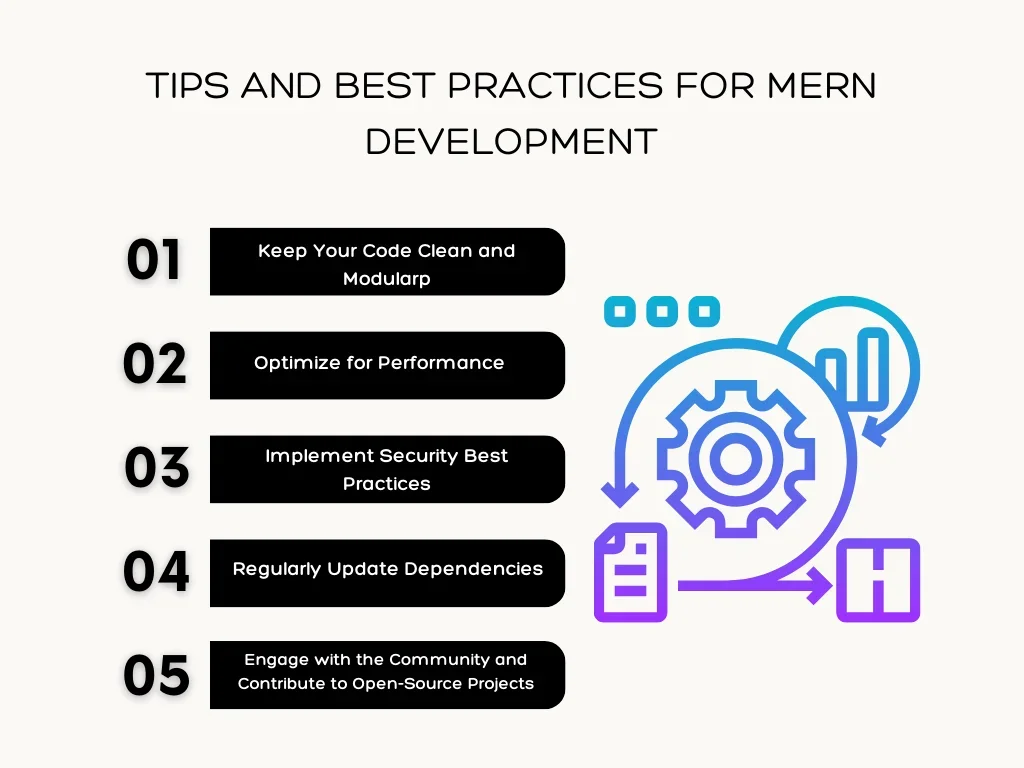
A proficient full-stack MERN developer requires more than just understanding the technologies. Applying best practices ensures efficient, maintainable, and scalable applications. Here are five essential tips for excelling in MERN development.
1. Keep Your Code Clean and Modular
Clean code enhances readability and maintainability. Break your code into small, reusable modules. Each module should handle a specific functionality. This modular approach allows easier debugging and testing. When your application grows, you will manage it better with well-organized code.
2. Optimize for Performance
Performance plays a crucial role in user experience. Implement efficient algorithms and minimize redundant operations. Use tools like MongoDB indexes to speed up database queries. Leverage React's useMemo and useCallback hooks to optimize component rendering. Constantly monitor your application's performance and make necessary adjustments.
3. Implement Security Best Practices
Security must be a top priority in your development process. Sanitize user inputs to prevent SQL injection and cross-site scripting (XSS) attacks. Use HTTPS to encrypt data transmission. Implement proper authentication and authorization mechanisms. Regularly update your dependencies to fix known vulnerabilities. Security ensures user trust and protects sensitive data.
4. Regularly Update Dependencies
Outdated dependencies can introduce security risks and compatibility issues. Check and apply updates regularly. Use tools like npm-check-updates to automate this process. Ensure your application runs with the latest stable versions of all packages. This practice helps maintain a secure and reliable application.
5. Engage with the Community and Contribute to Open-Source Projects
The MERN stack community offers a wealth of resources and support. Engage with other developers through forums, social media, and meetups. Contributing to open-source projects enhances your skills and helps you stay updated with the latest trends. Sharing knowledge and collaborating with others promotes growth and innovation.
Key Takeaway
Full stack MERN development offers a streamlined approach to building modern web applications. Combining MongoDB, Express.js, React, and Node.js, the MERN stack allows developers to work efficiently using a single language like JavaScript. This leads to faster development cycles and easier debugging, which benefits businesses looking to launch robust applications quickly.
Becoming a MERN developer opens numerous career opportunities. Companies value professionals who can handle both front-end and back-end tasks. Mastering the MERN stack equips you with versatile skills, making you a valuable asset to any tech team. You'll be able to create dynamic and scalable applications that meet various business needs.
Ready to dive into full stack MERN development? Check out our resources page. We will guide you through the latest trends, tips, and best practices to enhance your development journey.

